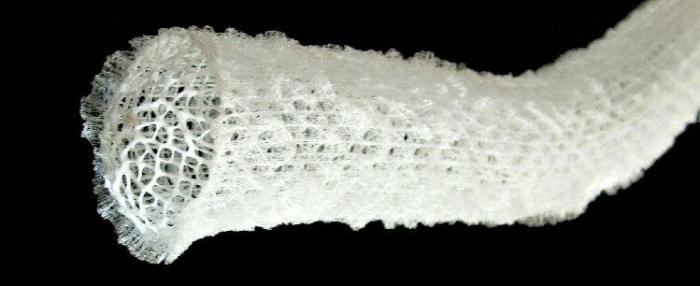 In the deep ocean, the Monorhaphis chuni, a type of glass sponge, can grow to be 10 feet long. A single silicon spine, or spicule, anchors itself to the seafloor, around which the softer sponge body is supported. The spine of the Monorhaphis chuni is by far the largest bio-silica structure of any known animal. The sponge is also among the longest-lived animals on earth, living many thousands of years. One Monorhaphis chuni spine investigated by researchers is from a sponge believed to approximately 11,000 years old.
In the deep ocean, the Monorhaphis chuni, a type of glass sponge, can grow to be 10 feet long. A single silicon spine, or spicule, anchors itself to the seafloor, around which the softer sponge body is supported. The spine of the Monorhaphis chuni is by far the largest bio-silica structure of any known animal. The sponge is also among the longest-lived animals on earth, living many thousands of years. One Monorhaphis chuni spine investigated by researchers is from a sponge believed to approximately 11,000 years old.
Scientists have discovered that the structure and chemistry of the long-lived sponge can provide a record of ocean temperature and sealife diversity. In the past 20 years, climate scientists have been researching the possible uses of sponges as proxies for long-term changes in the climate.
In the 2012 paper, the team of researchers, based in China and Germany, proposed the possibility that M. chuni spicules could be a “paleoclimate archive,” which captured data about the climate of the distant past. The paper noted that the sea water temperature in the vicinity of the sponge increased at least once from less than two degrees Celsius to six to ten degrees Celsius. These temperature changes were not previously known and are due to eruptions of seamounts.
Recently, in a paper published Geophysical Research Letters, a team led by the same scientists showed how the ratios of silicon and germanium in sponge spicules could document the changes of silica in the ocean during the last deglacial period.
As noted by Sarah Lasko, writing in Atlas Obscura, the silicon available at different depths of the ocean depends in part on the lives and production of tiny algae, diatoms, which live closer to the ocean’s surface and suck up carbon dioxide as they photosynthesize. Silicon is a crucial nutrient in diatom life, and when they die, diatoms carry both carbon and silicon deeper down into the ocean. By looking at the changes in silicon and germanium ratios in the sponge spicules, it’s possible to better understand the long-term history of diatom production and its contribution to the global carbon cycle. These striking silicon spines, a wonder in their own right, hold secrets to the past that we’re just beginning to discover.
